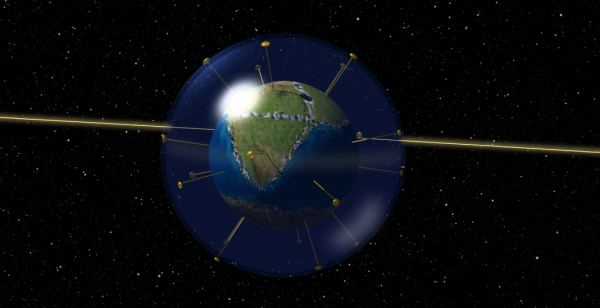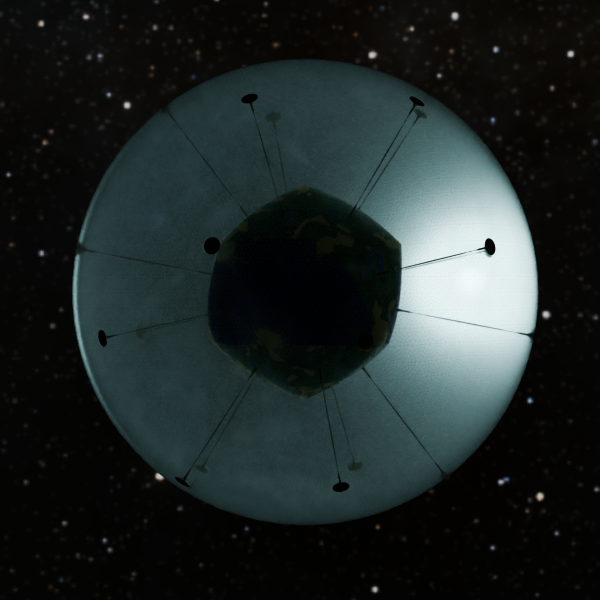BY LETTER
Hawking's Not Here
Galactography > Sephirotic Empires > Metasoft Version Tree
Galactography > Regions of Space > Outer Volumes
Galactography > Systems and Worlds > Systems & Worlds G - H
Galactography > Regions of Space > Outer Volumes
Galactography > Systems and Worlds > Systems & Worlds G - H
Miniature artificial planet with an Earth-like surface gravity | |
 Image from Steve Bowers | |
| Hawking's Not Here is a tiny supermundane shell ten kilometers across, with a black hole at its heart. | |
Hawking's Not Here is a miniature supermundane world built around an artificial black hole, located in the nefarious Pentagon Moons system. This worldlet follows a halo orbit in the L4 point between the primary of Pentagon Moons ("Solstar") and the innermost gas giant ("Byjove"). It was constructed after prior plans for the development of Pentagon Moons fell through and the system's owner, a Su named Dom Jovanus, rather petulantly collapsed a large mass of export-ready magmatter into a black hole to begin building a private luxury habitat. Since then, the world was become a minor tourist resort with a few hundred visitors annually.
This world was whimsically dubbed "Hawking's Not Here." It's a mere 10 kilometers in diameter (at least, it's structural shell is 10km in outer diameter), with a surface gravity of about 1G (1G at 5,200 meters from the black hole). It is swathed in a 5-kilometer thick, Terran-standard atmosphere held in place by a multi-layered Bluesky Worldhouse because the 326m/s escape velocity is insufficient to retain an atmosphere, regardless of the 1G surface gravity.
The terrain is sculpted into a faux-icosahedron, with 20 roughly triangular valleys and lakes surrounded by raised, rolling hills. The faces are about 6.4 kilometers along an edge and 14 square kilometers in area. The north and south poles host roughly circular "continents" of 5 triangular valleys each, while the equator hosts two equal-sized lakes separated by 2 additional land valleys that are effectively peninsulas for the continents. The lakes are connected by narrow straits at the tip of each peninsula. Overall, the shell's surface is about 60% land and 40% water.
Though many visitors suspect some philosophical, mystic, or whimsical reasoning for the icosahedral terrain, it was actually practical. With a 5km radius, Hawking's Not Here has disconcertingly close horizons (to baselines and many nebs). In fact, a simple spherical shell can seem like a large hilltop floating supported in its enshrouding blue sky. To avoid that perspective on most of the world (it is still available from valley-edge hilltops), its terrain was broken into 20 faces surrounded by elevated hills. As a result, the terrain appears to be broken into 12 triangular valleys and 2 rhomboidal lakes.
 Image from Tasp |
Engineering Details
Hawking's Not Here is almost a Tuphz engineering exercise in that it seems to avoid more advanced technology, like magmatter, as the "low" tech choices for Hawking's Not Here have a common characteristic: they are all easily developed and maintained with minimal nanofac support and even less in the way of high technology. (More correctly, it is a Lo Tek project.) The remainder of the miniature world was created by a modest exercise of the Pentagon Moons' idled industrial complex.The Hawking's Knot is an artificial black hole of about 4x10^18kg. It is too massive to generate an appreciable amount of Hawking Radiation (less than a milliwatt), but its output may be augmented by creating an accretion disk. The black hole was constructed with a strong magnetic field, nearly 4 Gauss at the inside of the shell's poles. Electromagnetic coils and grids in the surrounding shell are the primary means of stabilizing the shell with respect to the black hole. Conversion rockets on the inside of the shell supply a secondary, emergency means of keeping shell and black hole safely separated. 200m above the shell's surface - at the peak of the terrain overlay's hills - the gravity is almost exactly 1G. Gravity drops to about 0.25G at the Bluesky Worldhouse (10km from the Knot).
That 10,000m diameter shell was built primarily of diamondoid with some thin coatings of sapphire and quartz for protection from oxidation. To combat the enormous buckling moments of a 10km diameter sphere, the shell is necessarily quite thick - 200 meters - but is mostly foamed diamondoid separating solid, load-bearing inner and outer layers merely 10 meters thick each. The foamed volume of the shells are reservoirs for all manner of volatiles, CHON for the habitat, and fuels like helium-3. Above the structural shell is a terrain overlay. The total load of the atmosphere, terrain overlay, and shell leaves about a factor-of-3 safety margin against buckling.
The terrain overlay is elevated above the structural shell by at least 15 meters and up to 200 meters, and consists of several meters of granite, quartz, sapphire, and topsoil supported on foamed sapphire to produce lightweight topology that doesn't heavily burden the structural shell. The top of the terrain overlay averages 50m above the structural shell and is capped with the aforementioned minerals, plus several meters of topsoil. Hilltops along the edges of each face can be up to 250m above the structural shell. The lake faces hold up to 30m depth of water (with an impermeable rock and clay beds) and represent low points on the globe to guarantee drainage from the valley faces. The sapphire foam immediately below the terrain shell holds various drainage and maintenance systems. Mesobots and larger bots provide ecological and terrain maintenance service (like dredging silt-clogged lakes). Though largely made of rock and minerals, the terrain overlay does serve to store megatons of pure industrial metals suitable for supporting a middle tech industrial base and modest population.
Because of the oddities of Hawking's Not Here's size and large atmosphere, a simple day-night cycle from rotation is difficult; the atmosphere acts like a prism to keep most of the surface illuminated. Instead, a circular sunline, a toroidal structure with a 100m minor diameter, surrounds Hawking's Not Here at a 105km altitude (above the black hole), circling at slightly above orbital velocity to maintain its shape with tension. Adjustable reflectors minimize light wasted into space and selectively heat areas of the atmosphere for weather control. Day/night cycles are achieved simply by turning off the sunline and rendering the Bluesky Worldhouse opaque (which occludes the local primary's light). Several gigatons of ammonia are stored in the sunline, supplying hydrogen for fusion and nitrogen for Hawking's Not Here's atmosphere.
The multi-layered Bluesky Worldhouse that caps Hawking's Not Here's atmosphere includes a layer of water some meters thick (divided into millions of cells to control sloshing) to reduce the tensile stress imposed by atmospheric pressure, but remains quite taut from that atmospheric pressure. To stabilize the Worldhouse with respect to the structural shell (as atmospheric convection would otherwise shift the Worldhouse), twenty Pandifico tethers anchor the Worldhouse to the structural shell (tying to the center of each of the 20 "faces" of the shell) and provide active stabilization. They also serve as hosts for Information Age communication relays (an aesthetic choice by the creator) and 6 of the tethers mount elevators to provide access to the six "space ports" mounted atop the Worldhouse at its cardinal points.
Those "space ports" are large (120m diameter) spheres set in the Worldhouse. They serve as airlocks and ship maintenance facilities. The waist of the space ports is ringed by workshops, guest facilities, and fuel storage embedded between Worldhouse layers. (They also provide access to the Worldhouse's water shell, which can be an unusual swimming experience.) From the ground, the copper and gold insulation around the space port's facilities make the space ports appear like archaic clockfaces.
Hawking's Not Here is currently inhabited by several hundred expatriate Triskaidephilians who populate several primtech villages and a rustic resort, which has ultratech amenities concealed in its apparently primitive walls to support the needs of su and low transapient visitors without unduly upsetting the Triskaidephilian attendants. It serves as the customs facility for visitors to Pentagon Moons.
Related Articles
Appears in Topics
Development Notes
Text by Mike Miller
Initially published on 11 February 2014.
Image by Tasp added March 6, 2025
Initially published on 11 February 2014.
Image by Tasp added March 6, 2025






